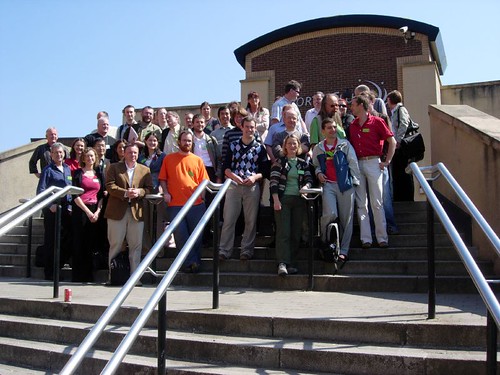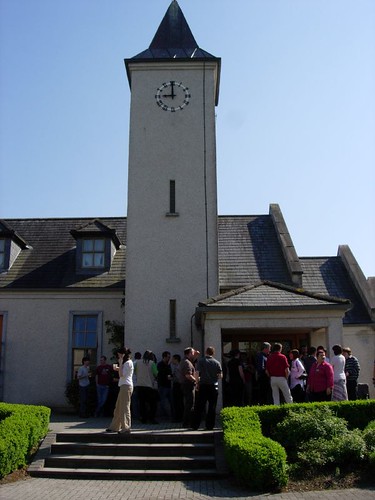An interview with Jenny Ambrozek
Back in August, when I was appointed Enterprise 2.0 Summit Ambassador, I discovered Jenny Ambrozek’s name on the workshops’ page. The name rang a bell- together with Joe Cothrel, Jenny had produced a report that generated a lot of reactions in the corporate world. It was one of the first publications that spoke about online communities in corporate environments, mentioning social software and backing it up with solid research. Until then, my interest for social software wasn’t taken seriously by any of my employers, and that was kind of torturing me.
I started following Jenny on Twitter(@sagenet) and we exchanged a few direct tweets (I was so honoured when Jenny asked for my opinion on the workshop outline!). Later on, the E2.0 Summit organisers asked me to do an interview with Jenny; I said yes right away, although I knew it wasn’t going to be easy for any of us to find time for it. In the end, after many private tweets exchanged, and days&nights of going back and forth via a shared Google Doc, the (asynchronous) interview is here:
Can you tell me a bit about yourself? What was your professional trajectory and what were the circumstances that led to your involvement with Social Networking?
Jenny Ambrozek: My interest in collaborating online began in my native Australia with a pre-Web Videotex venture. Moving to the United States I worked at Prodigy, the pioneering online consumer service. Always intriguing to me is how the skills I learned about developing relationships in early online environments are as timely and relevant today, regardless of technological changes or advances. Facilitating human interactions and sharing underpins successful collaboration. By the early 2000’s, working as a consultant, I’d confronted the human and structural realities within organizations that limited the success of collaboration initiatives. In 2003 I met Patti Anklam and was introduced to social network analysis. I’m convinced applying what we know about the science of social networks is vital for value creating enterprise collaboration and productive stakeholder engagement. (More about my professional trajectory is available in my Enterprise 2.0 Profile and a Knowledge Magazine article).
When I first read about your workshop at the E2.0 Summit, I had a revelation: “this must be THE Jenny Ambrozek who co-authored the famous 2004 report “Online Communities in Business 2004: Past Progress, Future Directions”. I was a member of AOK at the time, and I remember you and Joe Cothrell participating in the Star Series conversations. I remember being absolutely thrilled when I read about your report, it was exactly what I needed to convince the people around me that blogs and wikis were there to stay, and online communities in corporate environments were important for the future of the companies. I’m wondering if you estimated the huge impact this report was going to have when you started to work on the survey. What lead you to that initiative?
Jenny Ambrozek: I’m delighted that you found our study useful although you are perhaps too generous in crediting our report with a “huge impact”. However, I do think Online Communities in Business 2004 is important for capturing the perspectives and thoughts of leading practitioners in the field at the cusp of the Web 1.0 to Web 2.0 transition. In 2003, Joe Cothrel and I were watching the pioneering online services disappear and social software attracting a mass audience. We wanted to understand the enterprise impact so we initiated the study, reached out to practitioners we knew as thought leaders and sought their insights. Beyond our findings summarized in the report, I recommend reading the full free text comments wiki that SocialText provided. While the technology has evolved, the industry leaders’ wisdom about the practicalities of facilitating sustainable online communities, networks and teams is timeless.
You are writing a blog in collaboration with Victoria G. Axelrod, 21st Century Organization, where you share a lot of interesting material. Can you tell us what is the mission of this blog?
Jenny Ambrozek: Victoria Axelrod is a leading organizational strategist I was fortunate to meet in 2005. We instantly discovered a shared concern to understand the impact of low cost emergent collaboration tools (Web 2.0) on organizations. We started blogging seeking answers to a simple question: “What defines a successful 21st Century Organization?”
One of your presentations posted on Slideshare 3 years ago, Open netWORKing Organizations Co-generating Business Value, advocates that strategy drives all initiatives(slide 17). However, you seem to place the culture of the organisation at the centre of any initiative. This is the context, the playground where the action takes place, the canvas we’re trying to work on. Can you give us your view on fostering a culture of collaboration in an organisation? Is this always feasible?
Jenny Ambrozek: Your question goes to the heart of the matter. There is a difference between organizations who embrace Enterprise 2.0 and those who resist. This slide was developed by my blogging colleague Victoria Axelrod , who explains there is no culture when a company starts up. It derives from the values, beliefs, practices, the key players act out as they interact with the marketplace (stakeholders) to make their business happen. That complex, messy human process is captured in the slide as the interaction of the 4 S’s: Strategy, Structure, Systems and Shared Values. Because an organization’s culture develops through interaction and is dynamic, not static, it cannot be dictated, making “culture change” almost impossible.
Given those complex interactions, my workshop builds from the 1990’s Xerox Parc Research that identified the simply profound principle: “Organizations are webs of participation. Change the patterns of participation, and you change the organization.” (John Seely Brown & Estee Solomon Gray 1995 “ People are the Company, Fast Company.)
Look around for a moment and envision the companies who are identified as Enterprise 2.0 leaders. Those companies have accepted the value of allowing employees different patterns of participation, of more open knowledge sharing within their organization and beyond—bringing outside partnerships and knowledge into the organization.
By viewing organizations as networks, we can draw on knowledge from social network science to intentionally facilitate the networks and patterns of participation essential to achieving a business objective. A “Social Networking Culture” is a by-product.
And finally, can you tell us a few words about what are you planning for the workshop you’re giving before the E2.0 Summit in Frankfurt, “Social Networking Culture – Made Simple”. Two of the items on the agenda, “Thinking Networks – Personal Network Drawing Exercise” and “Applying Network Mapping to Participants’ Enterprise 2.0 Projects” made me very curious. What will you ask us to do ( if you can disclose this, of course)?
Jenny Ambrozek: Of course. The network mapping exercises will help participants understand how their work and organizations are accomplished through networks. (The Personal Network Drawing exercise is public, published in The Sustainable Enterprise Fieldbook, Chapter 8.) Then we apply that network mindset to participant projects, thinking through key people to be engaged, interactions to be facilitated and contributions needed for success.
I’m delighted that Mark Masterson will be joining the workshop to share his company CSC’s use of Organizational Network Analysis (ONA) as a foundation for their award winning, enterprise-wide C3 collaboration platform. Understanding the networks of people to be engaged underpinned CSC’s C3 implementation and ensured employees across the globe joined immediately and participated actively.
The workshop introduces participants to the network analysis ideas that CSC applied.
October 09 2010 | conference and E2.0 | 1 Comment »

